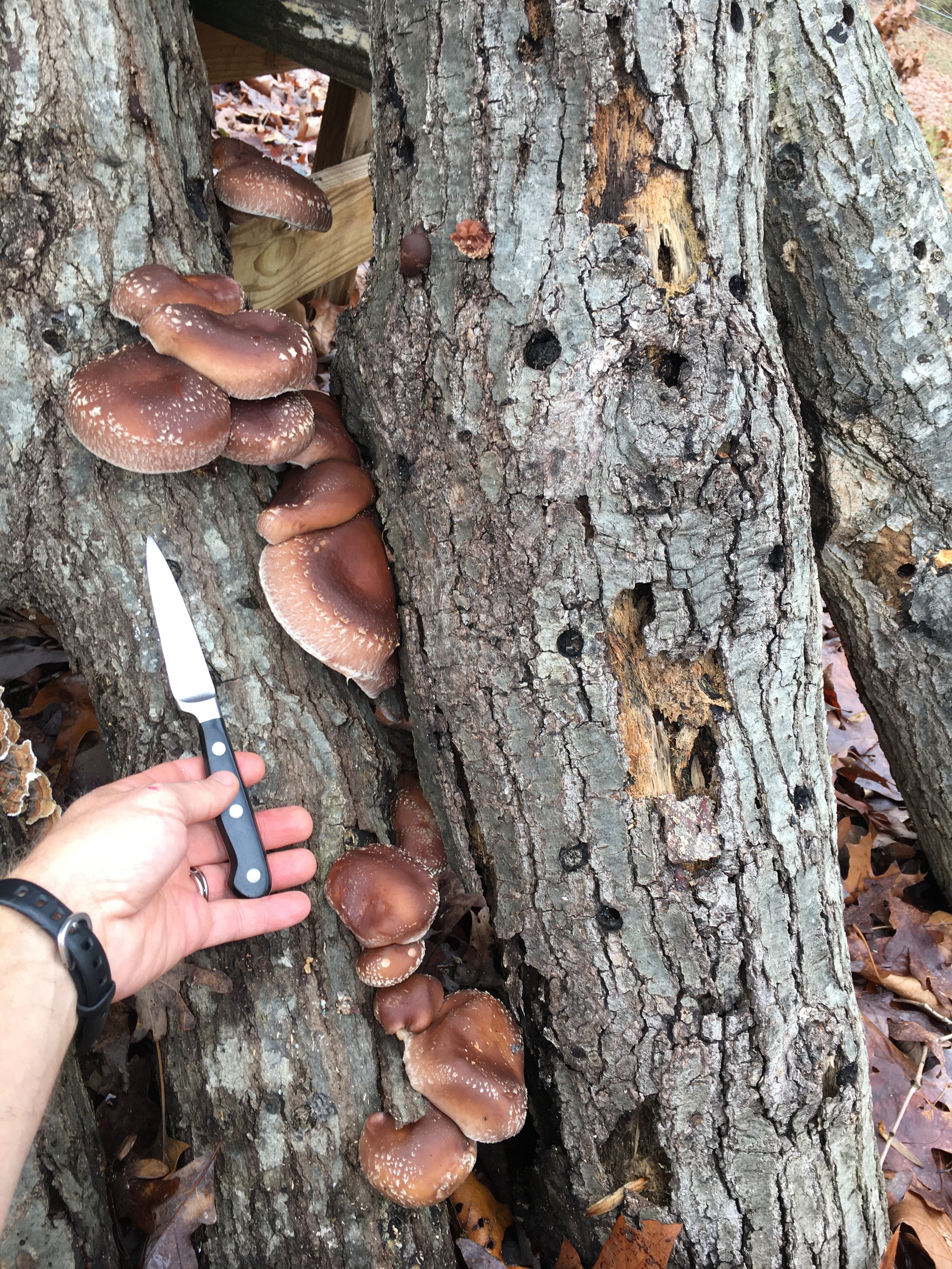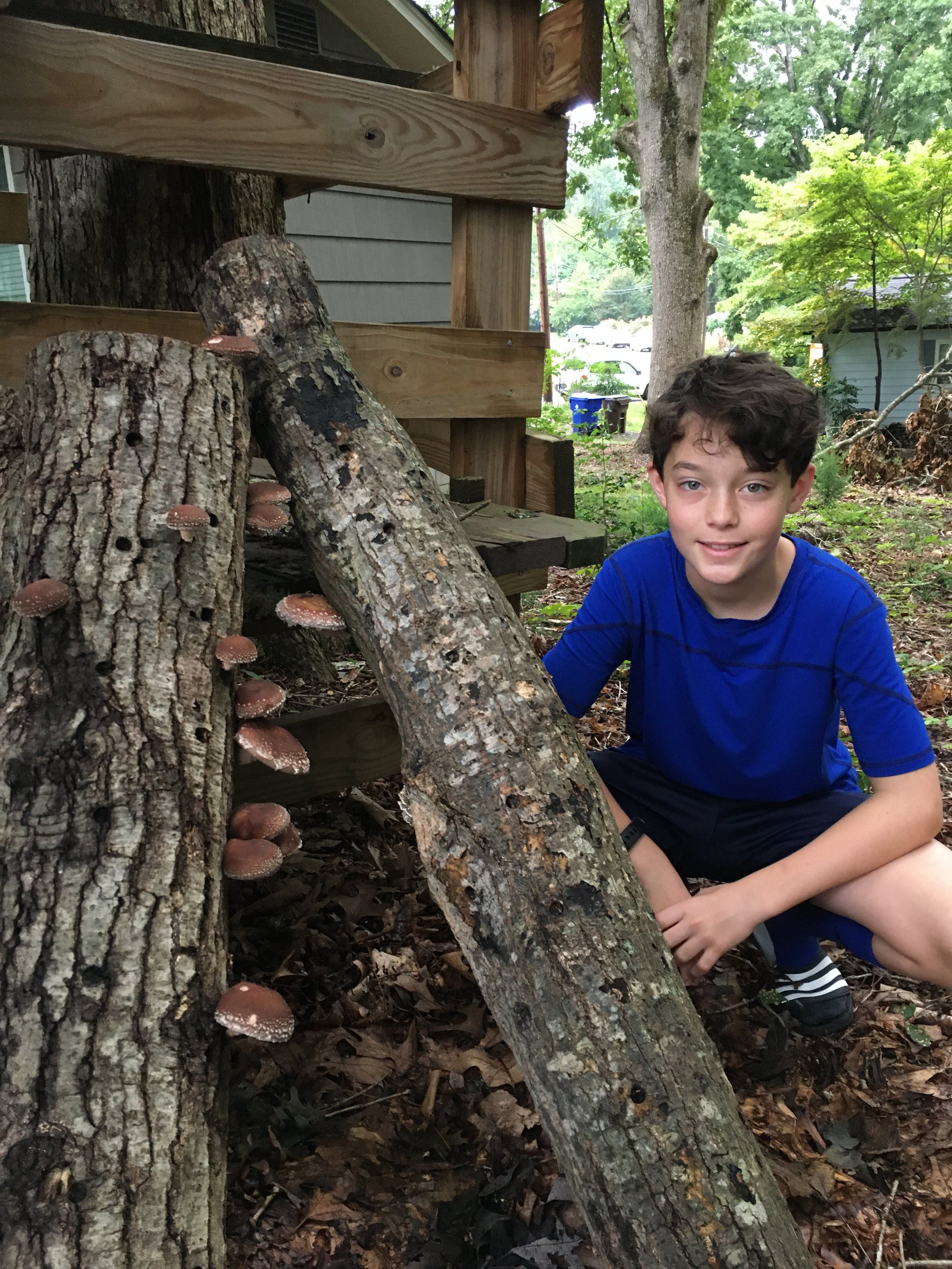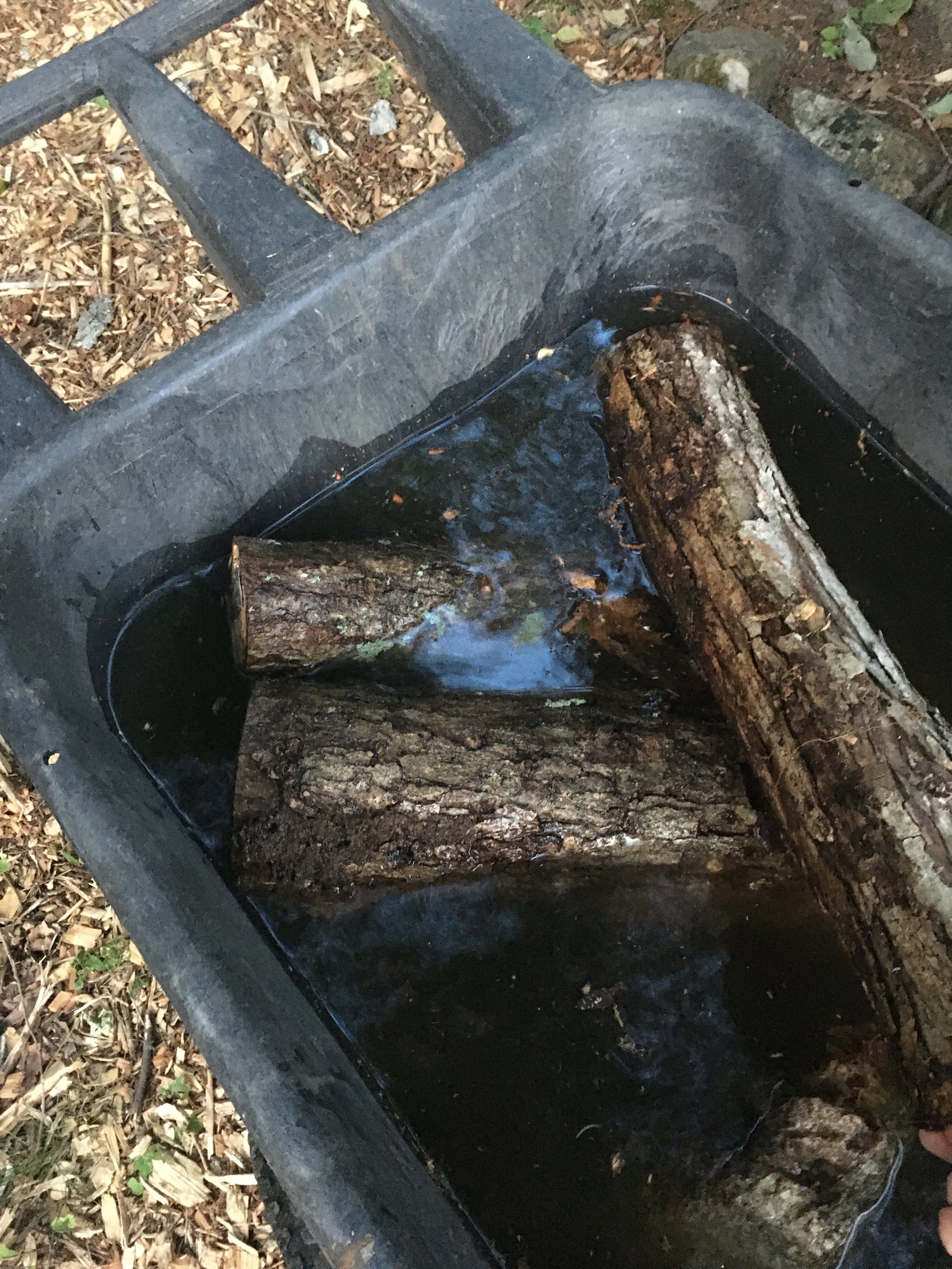
Mushroom Garden Network
Look for Spring 2023 Donko Shiitake on logs from 2020 and 2022
In 2022 I found some “donko shiitake” on my 2020 logs. So it happened again today! I included here a photo of what my log looks like with the flush. I harvested the largest mushrooms (also pictured). I left some smaller ones on my log because it is supposed to rain tomorrow. If the rain comes in time, those smaller donko shiitake might get a little larger and make more food for my family.
Earlier this winter during a warm spell, I found some shiitake on some logs that we inoculated in 2022.
IF YOU INOCULATED A LOG IN 2022, PLEASE CHECK YOUR LOGS REGULARLY. The mushrooms in spring time can get eaten by slugs and fungus gnats if you are not quick to find them. Mushrooms will “fruit” in just a day or so. If you wait too long, you might not get to eat them before wild creatures get to them. Those creatures are designed to eat mushrooms and turn them into creature bodies and babies.
Oak Ridge trees turn into shiitake mushrooms which turn into creature bodies.
You might try protecting your mushroom logs. Please share on the google group if you have success reducing slug and fungus gnat damage.
The log on the far right has the shiitake “donkos”. I inoculated that log in 2020.
This is what shiitake donkos look like. They are delicious and beautiful.
Substantial Flushes from 2020 logs
These larger flushes happened on 2020 logs.
Please hang in there if you inoculated a log in 2022. All of the literature says to expect a small flush in the first 12 months. The larger flushes happen in 24 months.
The log on the left must have flushed out earlier this week. The larger log on the right has a few tiny mushrooms.
From Rebecca Williams’s 2020 log
Don't give up on 2020 logs!
This log and the logs near it have been infected by other forms of competitive fungi. In particular I’ve noticed hypoxylon and turkey tail mushrooms. On the recommendation of the folks at Field and Forest, I isolated these logs from other logs that do not have as many signs of infection. In other words, I didn’t give up on them.
This was 481.5 grams of shiitake mostly from one log. That’s just shy of 1 lbs of shiitake.
You can see a hypoxylon “canker” near the top of the log on the right hand side of the picture.
Next to a human for scale reference.
Look for signs of life for 2022 Growers!
Greetings! These are some signs of life for shiitake log growers who purchased logs this past March 2022.
Your logs may show some signs of a spawn run. If you look on the end of your log, you may see some whitish patches indicating that fungal hyphae are growing throughout the log.
If you do not see these signs it’s OK!
If you do see these signs, feel free to share your pictures on the Google group or with your family and friends.
I have noticed that the white patches are more visible adjacent to the inoculate site closest to the end of the log.
A straight on look at the end of a log that was inoculated in March/April of 2022.
The white patches may appear on the end of the log closest to the inoculate site.
Yes. Both of the obvious white patches on the end of my log match up with inoculate sites that were close to the end of the log.
Here’s a log from 2020 where the mycelium populates most of the log. I have noticed that they get bright white if the shiitake are about to flush. Maybe our recent rains have convinced this log to give some mushrooms.
Shocking Logs: Jason tries, too.
At the end of May I tried a force fruiting experiment with some small white oak shiitake logs from 2020. I was wondering if a “soaked” log will initiate fruiting in an “un-soaked” log.
May 22, 2022 - Four small white oak logs that I inoculated in 2020.
May 22, 2022 - I soaked two of the logs for about 6 hours in my wheel barrow. The water was from my rain barrel. It looks like I have more than two logs in my wheel barrow. That’s because I used some other nearby logs to weigh down the inoculated logs.
May 22, 2022 - I re-placed the soaked logs in my stacks. Each stack had one of the soaked logs.
By May 30, 2022 - I had some size-able shiitake on one of the stacks. Take note of that happy slug!
By June 2, 2022 both stacks had numerous shiitake mushrooms. Most of the mushrooms appeared on the soaked log. Some of these mushrooms are overly mature, too large!
Since both logs in each stack gave mushrooms even when I only soaked one of the logs in each stack, I wonder if the shiitake mycelium in the soaked logs are able to signal to the connected logs that it’s a good time to flush.
I wonder if I would get a more substantial flush if I soaked all four logs.
I am curious if these logs were ready to flush anyway even if I had not soaked them.
Next time I will soak just two of the logs from one of the stacks and none of the logs in the other stack. I also plan to soak them in the heat of the summer to see if they will fruit even when conditions are not favorable.
I welcome other folks who are willing to give this a try. Feel free to communicate your findings to the group.
Shocking Logs: Kelly Abner's big flush!
From Kelly Abner:
“Hi Jason- I’m having great success w/ my 2020 log! The yield from the last 3 days’ harvest has already covered the cost of the log. I read that chlorine in city water is not a+ for the shrooms, so I filled a tub and let it sit in the sun for 24 hours, then I soaked the log, about 10 days ago, for 24 hours. One week later, I was able to begin harvesting- yum!!!”
A big flush. Take note of the roofing tiles underneath. Some of my logs are on dirt. Some are on leaves. It’s ok to work with what you have available.
“I saw some tips to use an insecticidal soap on the ground, place roofing tiles or rocks under the logs, and to keep logs 6” off the ground, all of which seems to help. I also made a cage to keep the varmints out. I wish I had purchased another log in March this year!”
This is a cool cage idea! I bet that these mushrooms do not have slug holes like mine.
Last year we had some questions about soaking our logs. So Kelly provided some clear answers!
I asked Kelly to please share her resources. Below are two links that she sent to me. I read both of these articles. They do help us shed light on ways to produce shiitake almost on demand.
If your log is heavy and you cannot lift it easily. Or if you don’t have a good way to submerge your log in water, you do not need to “shock your log”. If you just want to be patient and wait, you will get shiitake mushrooms periodically in the Spring and the Fall after rains or temperature changes. It’s ok to be hands-off about it. You might not get big flushes like Kelly got, but your log will continue to produce for years.
I advise you to place your log where you can see it especially. The mushrooms will arrive quickly and disappear just as quickly.
After seeing what soaking can do, I do plan to try soaking a few of my smaller logs just to see what happens!
FOR 2022 GROWERS: You will not get mushrooms if you shock your logs this year (2022). Your shiitake need more time to colonize the log. When we inoculated in March 2022, we used fresh logs that had plenty of stored moisture. Keep your logs in the shade and allow them to get rain. I sprinkle my logs with water if I have not gotten any recent rains.
Helpful articles:
Article: Everything Mushrooms “A Shocking Logs Blog”
Article: Permies “At What Stage Should Mushroom Logs be Soaked?” see posting #2 Marco Banks
What's happening inside your shiitake log?
The spawn that you planted on March 5, 2022 is growing very fine filaments called hyphae that are actively eating their way throughout the oak log. The network of hyphae, known collectively as mycelium, will run throughout the log for at least 12 months as the shiitake claims nutrients from the log. During this time the shiitake will develop specialized enzymes that will break down the long-chain biopolymers like lignin and celluose that make up the wood structure. If the shiitake mycelium encounter competitive fungi, they may combat the competitors with anti-fungal compounds. If the shiitake mycelium encounter competitive bacteria, they may create anti-bacterial compounds to stave off and defend the food they hope to consume.
When the mycelium colonize the log entirely, they store the moisture and nutrients until the conditions are just right for them to form “fruiting bodies”. The fruiting bodies are the mushrooms that we like to eat. The fruiting bodies are largely composed of chitin, a biopolyer that provides structure to the fungal cell walls. Ultimately, the chitin molecules come from the molecules of lignin and cellulose that the shiitake consumed and re-organized during the spawn run.
Every time that the shiitake make fruit, the mushroom releases stored resources into the environment. Sometimes you eat the mushrooms and the oak log becomes part of you. If you don’t get to it fast enough, the oak log becomes part of a squirrel or a slug in your neighborhood.
Here is a link to the presentation from my workshop where I introduced this process with help from this valuable book written by Tradd Cotter called Organic Mushroom Farming and Mycoremediation.
My 2022 log looks like a cut piece of wood with wax-covered holes along the edges.
The mycelium in this log from 2020 populates the entire log from end-to-end with the white mycelium that sometimes turns splotchy black. Little or no wax remains on the holes we drilled in 2020.
I noticed shiitake “pins” on my fully colonized log from 2022. Under favorable conditions, these pins may become full size mushrooms this week. Pins may come out of any spot on the log in whatever location suits the mushroom formation best.
Second Flush Early April on 2020 logs
I am starting to see a second flush on my 2020 logs.
If you will notice, the larger mushroom in my hand is very mature. It will have a shorter shelf life. You might be able to see tiny slugs eating away at the stem.
We will still consume the mature mushroom (after we clean off the slugs).
I prefer the smaller mushrooms with caps that are not fully opened. They taste better and have fewer insects and slugs.
2020 Shiitake Logs Are Flushing Now!
This looks like a big flush. The second year is supposed to be the best year according to several publications.
This was the “Beltane” strain of shiitake planted in our logs in 2020.
I inoculated this log with shiitake in 2020. Each arrow points at a pin. The black areas on the log are a “weed” fungus known as hypoxylon. The hypoxylon will reduce the long-term yield of the log. But for now I can enjoy delicious shiitake. This was the strain called “Beltane”.
This log has a few more shiitake “pins” on the back side, not visible in this picture.
Got Candles? Please recycle them at the Winter Farmers' Market.
We are collecting old candles.. tapers or pillars, for our next Mushroom Log Project. NOT candles in glass jars, please. Just the wax. We will melt these down for use in our mushroom logs.
Scented, unscented, colored, uncolored… doesn’t matter! We will be collecting candles at the Winter Farmers’ Market on Saturday March 19 and Saturday March 26.
Your old dining candles can help create… DINNER!
Sealing a log with wax, after injecting it with shiitake mushroom spawn. Spring 2022.


























